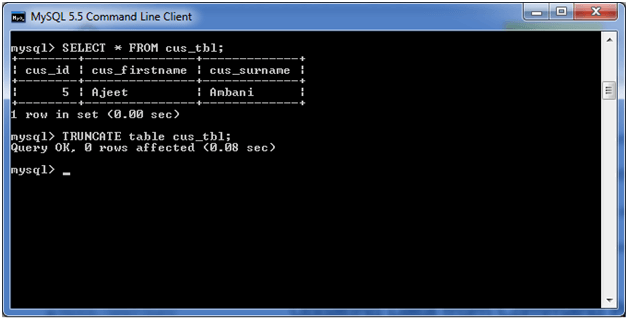What happens when we truncate a table? What is the stored procedure to truncate tables? Do I need to reindex after TRUNCATE TABLE? TRUNCATE TABLE cannot activate a trigger because the operation does not dividual row deletions.

For more information, see CREATE TRIGGER (Transact-SQL). You can also use DROP TABLE command to delete complete table but it would remove complete table structure form the database and you would need to re-create this table once again if you wish you store some data. You must disable the constraint before truncating the table.
An exception is that you can truncate the table if the integrity constraint is self-referential. If a domain index is defined on table , then neither the index nor any index partitions can be marked IN_PROGRESS. You cannot truncate the parent table of a reference-partitioned table.

TRUNCATE TABLE entfernt alle Zeilen aus einer Tabelle, die Tabellenstruktur (Spalten, Einschränkungen, Indizes usw.) dagegen bleibt erhalten. TRUNCATE TABLE removes all rows from a table, but the table structure and its columns, constraints, indexes, and so on remain. When you issue the TRUNCATE TABLE statement, the database system deletes all rows from the table by deallocating the data pages allocated by the table. By doing this, the RDBMS can reduce the resources for logging and the number of locks that need to acquire. It requires the DROP privilege.
SQL DROP TABLE Statement. Introduction to DbTRUNCATE TABLE statement. The DELETE statement without a WHERE clause allows you to delete all rows from a table. However, if you have a table with a large volume of data, the DELETE statement will not be efficient. Fortunately, Dbprovides the TRUNCATE TABLE that also delete all rows from a table , but in a more efficient.
In SQL, the TRUNCATE TABLE statement is a Data Definition Language (DDL) operation that marks the extents of a table for deallocation (empty for reuse). The result of this operation quickly removes all data from a table , typically bypassing a number of integrity enforcing mechanisms. Use the TRUNCATE TABLE statement to remove all rows from a table. Deletes all of the rows from a table without doing a table scan: this operation is a faster alternative to an unqualified DELETE operation.
To execute a TRUNCATE comman you must be the owner of the table or a superuser. Removes all rows from a table but leaves the table intact (including all privileges and constraints on the table ). Also deletes the load metadata for the table , which allows the same files to be loaded into the table again after the command completes. In this case, the TRUNCATE TABLE CASCADE statement deletes all rows from the table _name, and recursively truncates down the associated tables in the chain. Note that the TRUNCATE TABLE CASCADE statement requires the foreign key constraints defined with the ON DELETE CASCADE clause to work.
For ex: i want to reset all the data and keep last days inside the table. Truncating a table is also a lot easier than dropping the table and recreating it. In this syntax, you specify the name of the table which you want to remove all data after the TRUNCATE TABLE keywords.
However, it is a good practice to use the TABLE keyword to distinguish between the TRUNCATE TABLE statement and the TRUNCATE () function. The TABLE keyword is optional. TRUNCATE TABLE is functionally identical to DELETE statement with no WHERE clause: both remove all rows in the table.
Before we get into the. Even though the TRUNCATE TABLE statement removes all data from a table , it does not fire any ON DELETE triggers associated with that table. Operations other than SELECT that modify the table being truncated must wait for the truncating transaction to commit or roll back. If your system often has concurrent sessions that select against a table that is truncate note that the TRUNCATE command resets the table rowcount statistics to zero.
Removes all storage associated with a table , while leaving the table definition intact. TRUNCATE TABLE auto-commits the current transaction after statement execution and cannot be rolled back. We cannot use a Where clause in this. Delete command logs entry for each deleted row in the transaction log.
If concurrent access to a table is require then the DELETE command should be used instead. TRUNCATE cannot be used on a table that has foreign-key references from other tables, unless all such tables are also truncated in the same command. Checking validity in such cases would require table scans, and the whole point is not to do one. In this tutorial you will learn how to quickly delete all rows from a table using SQL. If the table to be truncated has an identity column, the counter for that column is reset to the seed value when data is deleted by the TRUNCATE TABLE statement but not the DELETE statement.
This post describes Truncate statement with its syntax and example.
Nincsenek megjegyzések:
Megjegyzés küldése
Megjegyzés: Megjegyzéseket csak a blog tagjai írhatnak a blogba.